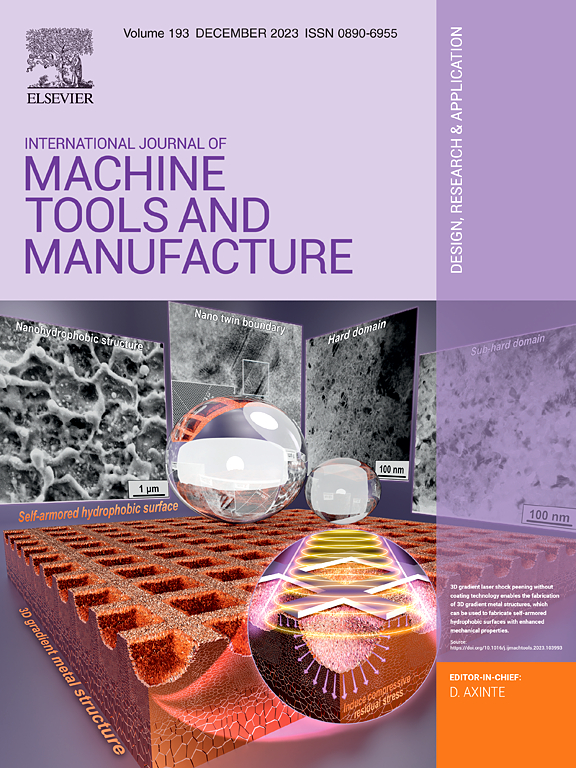热循环调控抑制激光定向能沉积镍基单晶高温合金热裂
IF 18.8
1区 工程技术
Q1 ENGINEERING, MANUFACTURING
International Journal of Machine Tools & Manufacture
Pub Date : 2025-05-01
DOI:10.1016/j.ijmachtools.2025.104283
引用次数: 0
摘要
激光定向能沉积法制备镍基单晶(SX)高温合金,阻碍了SX结构对热裂的敏感性。因此,在L-DED过程中实现SX高温合金无裂纹对于推进该技术在SX涡轮叶片修复中的应用至关重要。基于凝固收缩和固体桥接理论,通过显微组织表征和热-力学耦合模拟,系统研究了L-DED法制备多道次多层DD6 SX的热裂纹形成机制。结果表明:热裂纹的萌生和扩展受通道间和层间区域的重叠特征控制,这影响了液膜的形成和应力-应变集中的局部化。结果表明,杂散晶粒的形成与热裂是相互放大的。为了解决这些挑战,一种新的热裂纹抑制策略是优化在通道间和层间区域的停留时间,以调节枝晶生长和元素偏析。因此,成功制备了三道五层镍基单晶样品,宽度为2-3 mm,无裂纹。将热裂纹抑制方法应用于单道次薄壁沉积,获得了高度超过10 mm,占比超过95 %的单晶结构。修复质量超过单晶刀片修复要求。本研究为热裂纹的热力学机制提供了新的见解,并为L-DED DD6 SX的裂纹缓解建立了科学的框架,从而提高了其在高端部件修复中的适用性。本文章由计算机程序翻译,如有差异,请以英文原文为准。

Suppression of hot cracking in Ni-based single-crystal superalloys fabricated by laser directed energy deposition through thermal cycle regulation
The fabrication of Ni-based single-crystal (SX) superalloys through laser directed energy deposition (L-DED) is hindered by the high susceptibility of SX structures to hot cracking. Therefore, achieving crack-free SX superalloys during L-DED is crucial for advancing the application of this technology in SX turbine blade repair. Based on solidification shrinkage and solid-bridging theory, this study systematically investigated the formation mechanisms of hot cracks in a multi-pass multi-layer DD6 SX prepared by L-DED through microstructure characterisation and coupled thermal-mechanical simulations. The results demonstrate that the initiation and propagation of hot cracks are governed by the overlapping characteristics at the inter-pass and interlayer regions, which influence the formation of liquid films and localisation of the stress-strain concentration. Furthermore, the results revealed that the formation of stray grains and hot cracking mutually amplified each other. To address these challenges, a novel strategy for hot crack suppression is to optimise the dwell time at the inter-pass and interlayer regions to regulate the dendrite growth and elemental segregation. Consequently, a three-pass five-layer Ni-based single-crystal sample with a width of 2–3 mm was successfully prepared, which was free of cracks. Moreover, the hot crack suppression method was applied to single-pass thin-wall deposition, achieving a single-crystal structure with height exceeding 10 mm and a proportion of over 95 %. The repair quality surpassed the requirements for single-crystal blade repair. This study provides new insights into the thermal-mechanical mechanisms underlying hot cracking and establishes a scientific framework for mitigating the cracks in L-DED DD6 SX, thereby advancing their applicability in high-end component repair.
求助全文
通过发布文献求助,成功后即可免费获取论文全文。
去求助
来源期刊
CiteScore
25.70
自引率
10.00%
发文量
66
审稿时长
18 days
期刊介绍:
The International Journal of Machine Tools and Manufacture is dedicated to advancing scientific comprehension of the fundamental mechanics involved in processes and machines utilized in the manufacturing of engineering components. While the primary focus is on metals, the journal also explores applications in composites, ceramics, and other structural or functional materials. The coverage includes a diverse range of topics:
- Essential mechanics of processes involving material removal, accretion, and deformation, encompassing solid, semi-solid, or particulate forms.
- Significant scientific advancements in existing or new processes and machines.
- In-depth characterization of workpiece materials (structure/surfaces) through advanced techniques (e.g., SEM, EDS, TEM, EBSD, AES, Raman spectroscopy) to unveil new phenomenological aspects governing manufacturing processes.
- Tool design, utilization, and comprehensive studies of failure mechanisms.
- Innovative concepts of machine tools, fixtures, and tool holders supported by modeling and demonstrations relevant to manufacturing processes within the journal's scope.
- Novel scientific contributions exploring interactions between the machine tool, control system, software design, and processes.
- Studies elucidating specific mechanisms governing niche processes (e.g., ultra-high precision, nano/atomic level manufacturing with either mechanical or non-mechanical "tools").
- Innovative approaches, underpinned by thorough scientific analysis, addressing emerging or breakthrough processes (e.g., bio-inspired manufacturing) and/or applications (e.g., ultra-high precision optics).

 求助内容:
求助内容: 应助结果提醒方式:
应助结果提醒方式:


